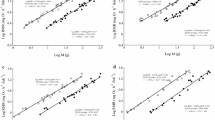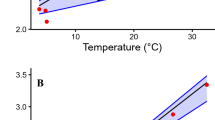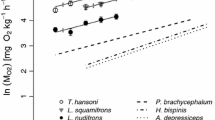Abstract
Resting metabolic rate\((\dot V_{O_{2[rest]} } )\) was measured in demersal stages of the teleostNotothenia neglecta Nybelin from the South Orkney Islands, Antarctica, from 1985 to 1987. The relationship between\(\dot V_{O_{2[rest]} } \) and body mass (Mb) conformed to the general relationship\(\dot V_{O_{2[rest]} } = aMb^b \), wherea is a proportionality constant andb is the scaling exponent.\(\dot V_{O_{2[rest]} } \) (mg O2 h−1) was found to scale toMb (0.82±0.011) in the summer (November to April, 1.6 to 1 850 g,n=56) and toMb (0.76±0.013) in the winter (May to October, 0.9 to 1 850 g,n=57) (values ofb are means ± SD). Although the scaling exponents were significantly different (P<0.01),\(\dot V_{O_{2[rest]} } \) was similar in the juvenile stages of summer- and winter-caught fish matched for body mass. The effects of activity on oxygen consumption was studied using a Brett respirometer. Adult stages had a factorial aerobic scope for activity\((\dot V_{O_{2[max]} } :\dot V_{O_{2[rest]} } )\) of 5.7, which is similar to that reported for demersal fish from temperate latitudes. The effects of temperature on resting metabolism was investigated in fish with similar sedentary lifestyles from the North Sea (Agonus cataphractus andMyoxocephalus scorpius) and the Indo-West Pacific (Paracirrhites forsteri, P. arcatus, Neocirrhites armatus andExallias brevis). Extrapolated values of\(\dot V_{O_{2[rest]} } \) for the tropical species approached zero at 5 to 10°C. For a standard 50 g fish,\(\dot V_{O_{2[rest]} } \) for the tropical species at 25°C was in the range 3.4 to 4.4 mg O2 h−1, compared with 1.3 mg O2 h−1 forNotothenia neglecta at its acclimation temperature. Thus, the maximum metabolic rate of sedentary tropical species at 24°C is likely to be 2 to 4 times higher than inN. neglecta at 0°C. This suggests that the energy available for sustained activity\((\dot V_{O_{2[max]} } - \dot V_{O_{2[rest]} } )\) is significantly lower in cold- than in warm-water fish.
Similar content being viewed by others
Literature cited
American Public Health Association (1976). American Water Works Association and Water Pollution Control Federation. Standard methods for the examination of water and waste water. 14th ed. American Public Health Association, Washington, D.C., p. 1193
Andriashev, A. P. (1987). A general review of the antarctic bottom fish fauna. In: Kullander, S. O., Fernholm, B. O. (eds.) Proceedings of the Fifth Congress on European Ichthyology, 1985. Swedish Museum of Natural History, Stockholm, p. 357–372
Archer, S. D., Johnston, I. A. (1989). Kinematics of labriform and subcarangiform swimming in the Antarctic fish,Notothenia neglecta. J. exp. Biol. 143: 195–210
Beamish, F. W. H. (1978). Swimming capacity. In: Hoar, W. S., Randall, D. J. (eds.) Fish physiology. Vol. VII. Academic Press, New York, p. 101–187
Bosch, I., Beauchamp, K. A., Steele, E., Pearse, J. S. (1987). Development, metamorphosis, and seasonal abundance of embryos and larvae of the Antarctic sea urchinSterechinus neumayeri. Biol. Bull. mar. biol. Lab., Woods Hole 173: 126–135
Clarke, A. (1980). A reappraisal of the concept of metabolic cold adaptation in polar marine invertebrates. Biol. J. Linn. Soc. 14: 77–92
Clarke, A. (1983). Life in cold water: the physiological ecology of polar marine ectotherms. Oceanogr. mar. Biol. A. Rev. 21: 341–453
DeVries, A. L., Eastman, J. T. (1981). Physiology and ecology of notothenioid fishes of the Ross Sea. Jl R. Soc. N.Z. 11: 329–340
Duthie, G. G. (1982). The respiration metabolism of temperature-adapted flatfish at rest during swimming activity and the use of anaerobic metabolism at moderate swimming speeds. J. exp. Biol. 97: 359–373
Forster, M. E., Franklin, C. E., Taylor, H. H., Davison, W. (1987). The aerobic scope of an Antarctic fish,Pagothenia borchgrevinki. Polar Biol. 8: 155–159
Gordon, M. S., Chin, H. G., Vojkovich, M. (1989). Energetics of swimming in fishes using different methods of locomotion. I. Labriform swimmers. Fish Physiol. Biochem. 6: 341–352
Holeton, G. F. (1973). Respiration of Arctic char (Salvelinus alpinus) from a high arctic lake. J. Fish. Res. Bd Can. 30: 717–723
Holeton, G. F. (1974). Metabolic cold adaptation of polar fish: fact or artefact? Physiol. Zoöl. 47: 137–152
Jobling, M. (1983). Towards an explanation of specific dynamic action (SDA). J. Fish Biol. 23: 549–555
Johnston, I. A. (1987). Respiratory characteristics of muscle fibres in a fish (Chaenocephalus aceratus) that lacks haeme pigments. J. exp. Biol. 133: 415–428
Johnston, I. A. (1989). Antarctic fish muscles — structure, function and physiology. Antarctic Sci. 1: 97–108
Johnston, I. A. (1990). Cold adaptation in marine organisms. Phil. Trans. R. Soc. (Ser. B) 326: 655–667
Johnston, I. A., Camm, J.-P., White, M. G. (1988). Specialisation of the swimming muscles in the pelagic antarctic fishPleuragramma antarcticum. Mar. Biol. 100: 3–12
Johnston, I. A., Johnson, T. P., Battram, J. C. (1991). Low temperature limits burst swimming performance in Antarctic fish. In: Guido de Prisco, B., Maresca, B., Tota, B. (eds.) Biology of Antarctic fishes. Heidelberg, Springer Verlag (in press)
Kennett, J. P. (1977). Cenozoic evolution of antarctic glaciation, the circum-antarctic ocean and their impact on global paleoceanography. J. geophys. Res. 82: 3843–3876
Londraville, R. L., Sidell, B. D. (1990). Ultrastructure of aerobic muscle in Antarctic fishes may contribute to maintenance of diffusive fluxes. J. exp. Biol. 150: 205–220
Morris, D. J., North, A. W. (1984). Oxygen consumption of five species of fish from South Georgia. J. exp. mar. Biol. Ecol. 265: 75–86
Saint-Paul, U., Hubold, G., Ekau, W. (1988). Acclimation effects on routine oxygen consumption of the Antarctic fishPogonophryne scotti (Artedidraconidae). Polar Biol. 9: 125–128
Scholander, P. F., Flagg, W., Walters, V., Irving, L. (1953). Climatic adaptation in arctic and tropical poikilotherms. Physiol. Zoöl. 26: 67–92
Tandler, A., Beamish, F. W. H. (1979). Mechanical and biochemical components of apparent specific dynamic action in largemouth bass,Micropterus salmoides Lacepede. J. Fish Biol. 14: 343–350
Wells, R. M. G. (1987). Respiration of Antarctic fish from McMurdo Sound. Comp. Biochem. Physiol. 88A: 417–424
Wieser, W. (1985). Developmental and metabolic constraints of the scope for activity in young rainbow trout (Salmo gairdneri). J. exp. Biol. 118: 133–142
Wohlschlag, D. E. (1960). Metabolism of an antarctic fish and the phenomenon of cold adaptation. Ecology 41: 287–292
Wohlschlag, D. E. (1962). Metabolic requirements for the swimming activity of three antarctic fishes. Science, N.Y. 137: 1050–1051
Wohlschlag, D. E. (1964a). Respiratory metabolism and ecological characteristics of some fishes in McMurdo Sound, Antarctica. In: Lee, M. O. (ed.) Biology of the Antarctic seas. Vol. 1. American Geophysical Union, Washington, D.C., p. 33–62
Wohlschlag, D. E. (1964b). Respiratory metabolism and growth of some antarctic fishes. In: Carrick, R., Holdgate, M. W., Prévost, J. (eds.) Biologie antarctique. Hermann, Paris, p. 489–502 (SCAR Symp.)
Author information
Authors and Affiliations
Additional information
Communicated by J. Mauchline, Oban
Rights and permissions
About this article
Cite this article
Johnston, I.A., Clarke, A. & Ward, P. Temperature and metabolic rate in sedentary fish from the Antarctic, North Sea and Indo-West Pacific Ocean. Mar. Biol. 109, 191–195 (1991). https://doi.org/10.1007/BF01319386
Accepted:
Issue Date:
DOI: https://doi.org/10.1007/BF01319386




